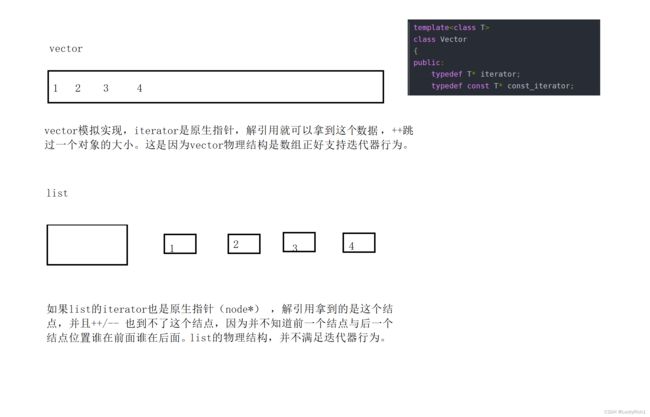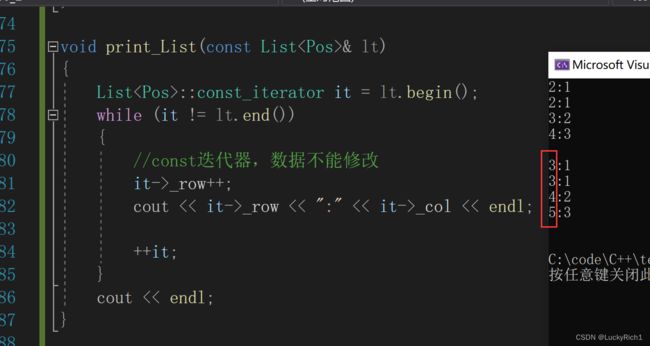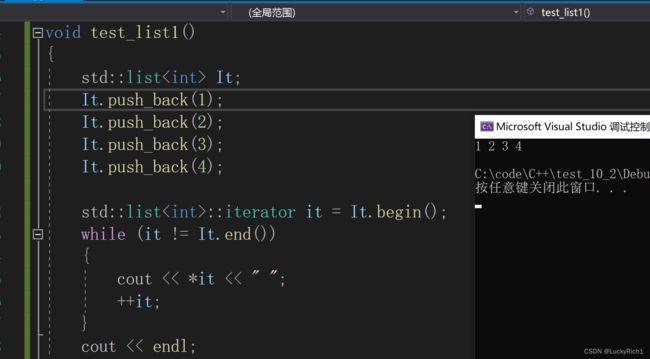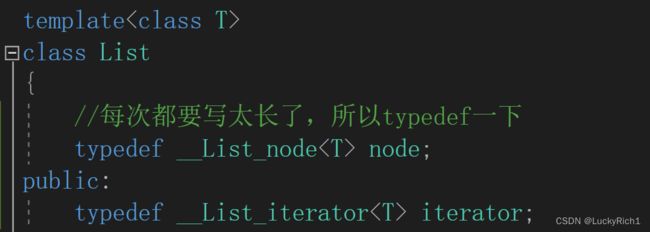C++list模拟实现
list模拟实现
- 1.链表结点
- 2.类模板基本框架
- 3.构造
- 4.插入+普通迭代器实现
-
- 4.1尾插
- 4.2普通迭代器实现
- 4.3对比list和vector的iterator
- 4.4迭代器的价值
- 4.5insert
- 4.6尾插头插复用写法
- 5.删除+erase
-
- 5.1erase
- 5.2尾删头删复用写法
- 6.析构+empty+size+clear
-
- 6.1clear
- 6.2size
- 6.3 empty
- 6.4 析构
- 7.拷贝构造+赋值运算符重载
-
- 7.1拷贝构造写法
- 7.2赋值运算符重载
- 8.const迭代器
- 9.类名与类型的区别
- 10.对于自定义类型迭代器遍历的功能实现
- 11.迭代器完整代码
- 12.vector与list对比
-
- 12.1vector优缺点总结
- 12.2list优缺点总结
- 13.迭代器失效问题
自我名言:只有努力,才能追逐梦想,只有努力,才不会欺骗自己。
喜欢的点赞,收藏,关注一下把!
库里面的list类模板,实现的是带头双向循环链表。这里我们和库实现的是一样的。
1.链表结点

这里链表结点实现的是一个模板,因为我们并不知道别人想在结点里放什么数据。
其次库里面结点指针是void*,而我们和库里面有一些细微差别,
//链表结点
template<class T>
struct __list_node
{
__list_node* _prev;
__list_node* _next;
T _date;
};
//struct和class一样,也可以是类关键字,并且里面的成员变量和成员函数默认都是public的。
2.类模板基本框架
template<class T>
class List
{
//每次都要写太长了,所以typedef一下
typedef __list_node<T> node;
public:
private:
node* —_head;
};
3.构造
template<class T>
struct __list_node
{
__list_node* _prev;
__list_node* _next;
T _date;
__list_node(const T& val)
:_prev(nullptr)
,_next(nullptr)
,_date(val)
{}
};
//构造
list()
{
//new对自定义类型会调用它的构造函数,因此,结点类必须要有一个构造
_head = new node(T());
_head->_prev = _head;
_head->_next = _head;
}
4.插入+普通迭代器实现
4.1尾插
void push_back(const T& x)
{
node* newnode = new node(x);
node* tail = _head->_prev;
tail->_next = newnode;
newnode->_prev = tail;
newnode->_next = _head;
_head->_prev = newnode;
}
4.2普通迭代器实现
注意list遍历只能用迭代器,或者范围for(底层是迭代器),不能用下标+[],因为vector物理结构是数组,而list底层是一个个按需申请的结点。
接下来我们自己实现一个迭代器。遍历链表。
首先来认识认识迭代器。
std::list<int>::iterator it = It.begin();

链表结点是一个个申请的,而vector和stirng是一次就申请连续的空间。

由于在前面学过封装,这里我们可以把指针封装起来,并且加上运算符重载(* ,++, !=)来支持,迭代器的行为。
template<class T>
struct __lsit_iterator
{
typedef __list_node<T> node;
node* _pnode;
T& operator*()
{
return _pnode->_date;
}
__lsit_iterator<T>& operator++()
{
_pnode = _pnode->_next;
return *this;
}
bool operator!=(const __lsit_iterator<T>& It)
{
return _pnode != It._pnode;
}
};
//迭代器
iterator begin()
{
//这里是匿名构造,但是__list_iterator缺少了构造,所以增加一下
return iterator(_head->_next);
}
iterator end()
{
return iterator(_head);
}
普通迭代器部分模板
template<class T>
struct __lsit_iterator
{
typedef __list_node<T> node;
node* _pnode;
__lsit_iterator(node* _node)
:_pnode(_node)
{}
T& operator*()
{
return _pnode->_date;
}
__lsit_iterator<T>& operator++()
{
_pnode = _pnode->_next;
return *this;
}
bool operator!=(const __lsit_iterator<T>& It)
{
return _pnode != It._pnode;
}
};

我们使用自己的iterator,结果也是正确的。这里不太懂得,可以调试一下,帮助理解。

4.3对比list和vector的iterator
iteratorr------->1.内置类型 2.行为像指针一样。
范围【begin(),end())

list,vector迭代器上层使用都是一样的。但是它们底层实现不一样。list的迭代器是自定义类型(封装+运算符重载),但vector的迭代器并不一定就是内置类型(原生指针)。
就如在linux环境和vs环境下,erase后pos位置失效不失效的问题,在linux环境下pos不失效,而vs环境下pos失效,这是因为在两个不同环境下,iterator底层实现是不一样的。linux下iterator是原生指针,vs对vector的iterator和list的iterator一样,都是指针的封装。所以iterator不一定就是指针
为什么vector和list这里都用" != “,而不是” < "呢?

这是因为,vector的物理结构(数组)可以满足" < ",但是list的物理结构并不能确定前一个结点与后一个结点位置谁大谁小,所以统一用 " != ",可以满足不同容器的迭代器。
4.4迭代器的价值
1.封装底层实现,不暴露底层的实现细节。
2.提供统一的访问方式,降低使用成本。
迭代器是一种框架,可能代码我们都会写,但是这种框架思维是最重要的。
从物理层面上看,vector和list的iterator物理结构都是指针,请问大小是几个字节呢?

vector迭代器是一个原生指针,list迭代器是一个指针类模板,类的大小是成员变量的大小+内存对齐,list迭代器我们就放一个node*指针,我们知道32位指针大小为4,64位指针大小为8;所以大小都是4/8字节。
虽然iterator变化都是指针的变化,但是它们的类型是不一样的,vector的iterator是内置类型(原生指针),list的iterator是自定义类型,编译器根据类型的不同所走的方式不同,list的iterator走的是调用函数,如++it,调用it.operator++()再把结构返回来,而vector直接使用,指针直接像后走4个字节。。这就是类型的力量。
4.5insert
iterator insert(iterator pos, const T& val)
{
node* newnode = new node(val);
node* cur = pos._pnode;
node* prev = cur->_prev;
prev->_next = newnode;
newnode->_prev = prev;
newnode->_next = cur;
cur->_prev = newnode;
return iterator(newnode);
}
4.6尾插头插复用写法
void push_back(const T& x)
{
//node* newnode = new node(x);
//node* tail = _head->_prev;
//tail->_next = newnode;
//newnode->_prev = tail;
//newnode->_next = _head;
//_head->_prev = newnode;
insert(end(), x);
}
void push_front(const T& x)
{
insert(begin(), x);
}
5.删除+erase
5.1erase
iterator erase(iterator pos)
{
assert(pos != end());
node* prev = pos._pnode->_prev;
node* next = pos._pnode->_next;
prev->_next = next;
next->_prev = prev;
delete pos._pnode;
//返回pos下一个位置
return iterator(next);
}
5.2尾删头删复用写法
__List_iterator<T>& operaotr--()
{
_pnode = _pnode->prev;
return *this;
}
void pop_back()
{
//iterator没有实现--运算符重载,所以补充一下
erase(--end());
}
void pop_front()
{
erase(begin());
}
6.析构+empty+size+clear
6.1clear
void clear()
{
iterator it = begin();
while (it != end())
{
it = erase(it);
}
}
6.2size
//一般想法就是遍历,统计一下个数,但是我们这里可以增加一个_size成员遍历,来统计个数
//然后再返回这个变量即可
//成员变量增加一个_size,构造都要改,但是我们实现了empty_initialize(),只要修改这里就可以
void empty_initialize()
{
_head = new node(T());
_head->_prev = _head;
_head->_next = _head;
_size = 0;
}
size_t size() const
{
return _size;
}
//插入和删除也需要相应的把_size加上。
6.3 empty
bool empty() const
{
return _size == 0;
}
6.4 析构
~List()
{
clear();
delete _head;
_head = nullptr;
}
7.拷贝构造+赋值运算符重载
7.1拷贝构造写法
//拷贝构造传统写法
List(const List<T>& it)
{
//由于构造+拷贝构造+赋值都要有这样写法,为了减少代码冗余
//专门写一个empty_initialize()
//_head = new node(T());
//_head->_prev = _head;
//_head->_next = _head;
empty_initialize();
for (auto e : it)
{
push_back(e);
}
}
但是这样写有一个问题。
list T是泛型, 如果T放的是内置类型还好说,但如果T放的是自定义类型,这里还涉及拷贝构造和析构。因此正确写法如下。
//拷贝构造传统写法
List(const List<T>& it)
{
empty_initialize();
//加个引用
for (auto& e : it)
{
push_back(e);
}
}
但是这样写,还是有问题,it是const修饰的对象,范围for变量底层是迭代器,走的是const的迭代器。但是在__List_iterator 还没有实现。这里先把拷贝构造和赋值写完,就说这个问题。
在string和vector模拟实现,拷贝构造和赋值运算符重载最终都用现代写法来实现。现代写法的主要思想:就是自己的事情让别人干,然后再交换一下。
拷贝构造现代写法复用构造函数

前面实现的是一个无参构造,想要复用构造函数,必须要实现这个一段区间的构造函数。
template <class InputIterator>
List(InputIterator first, InputIterator last)
{
empty_initialize();
while (first != last)
{
push_back(*first);
++first;
}
}
void swap(List<int>& x)
{
std::swap(_head, x._head);
std::swap(_size,x._size);
}
//拷贝构造现代写法
List(const List<T>& it)
{
//这里必须要申请带头结点,不然交换就会野指针,tmp析构的是就会报错
//也不能直接给_head(nullptr),这样tmp析构也会报错
empty_initialize();
List<T> tmp(it.begin(), it.end());
swap(tmp);
}
7.2赋值运算符重载
//传统写法
List<T>& operator=(const List<T>& it)
{
if (this != &it)
{
//this->clear()
clear();
for (auto& e : it)
{
//this->push_back(e);
push_back(e);
}
}
return *this;
}
赋值运算符重载现代写法的思想:复用拷贝构造函数
//赋值现代写法
//it这里调用拷贝构造函数
List<T>& operator=(List<T> it)
{
swap(it);
return *this;
}
虽然现在已经实现了拷贝构造和赋值运算符重载,但是迭代器没有实现const iterator 上面代码都会报错。

接下来实现const迭代器
8.const迭代器
回想一下vector实现的const迭代器
typedef T* iterator;
typedef const T* const_iterator;
List<int>::iterator it = It.begin();
//可能会以为在前面加上const 就是const迭代器了,但这样是不对的
const List<int>::iterator it = It.begin();
我们知道const修饰指针有不同位置
//const修饰*p1,*p1内容不能改变,p1指针可以改变
const T* p1
//const修饰p2,p2指针不能改变,*p2内容可以改变
T* const p2
而const迭代器类似p1的行为,保护指向对象不能改变,迭代器本身可以修改
//不符合迭代器的行为,因为它保护迭代器 本身不能修改,那么就不能++/--迭代器
const List<int>::iterator it = It.begin();
所以考虑一下,放在__List_iterator中;
//iterator it
//*it
//++it
T& operator*()
{
return _pnode->_date;
}
//可能还会想这样写,const修饰指针*this
//const iterator* const this 这样*this就不会改变了
//但是*this 是const iterator it
//*it
//++it 这样的话,可以解引用,但是不能++it
const T& operator*() const
{
//引用赋值,必须权限缩小或者平移,所以返回类型是const
return _pnode->_date;
}
template<class T>
struct __List_iterator
{
typedef __List_node<T> node;
node* _pnode;
__List_iterator(node* _node)
:_pnode(_node)
{}
cosnt T& operator*()
{
return _pnode->_date;
}
__List_iterator<T>& operator++()
{
_pnode = _pnode->_next;
return *this;
}
__List_iterator<T>& operator--()
{
_pnode = _pnode->_prev;
return *this;
}
bool operator!=(const __List_iterator<T>& It)
{
return _pnode != It._pnode;
}
};
但是对比普通迭代器和const迭代器,发现就只有operator*不一样,其他运算符重载都一样。
我们看库里是怎么实现iterator的。
暂时先不用管Ptr参数。

看到大佬是把普通迭代器和const迭代器实现放在一块,然后用Ref参数来做区分。
我们知道一个模板类,由于类型不同可实现不同的类。
如list < int > , list< char > 虽然用的是统一模板,但是由于类型不同,因此是不同的类。所以大佬方法是非常厉害的。
//typedef __List_iterator iterator;
//typedef __List_iterator const_iterator;
template<class T,class Ref>
struct __List_iterator
{
typedef __List_node<T> node;
typedef __List_iterator<T, Ref> self;
node* _pnode;
__List_iterator(node* _node)
:_pnode(_node)
{}
Ref operator*()
{
return _pnode->_date;
}
//__List_iterator& operator++()
//{
// _pnode = _pnode->_next;
// return *this;
//}
//普通迭代器和const迭代器返回类型不一样,因此typedef一下,比较方便。
self& operator++()
{
_pnode = _pnode->_next;
return *this;
}
//__List_iterator& operator--()
//{
// _pnode = _pnode->_prev;
// return *this;
//}
self& operator--()
{
_pnode = _pnode->_prev;
return *this;
}
//bool operator!=(const __List_iterator& It)
//{
// return _pnode != It._pnode;
//}
bool operator!=(const self& It)
{
return _pnode != It._pnode;
}
};
有了const迭代器,拷贝构造和赋值运算符重载就没问题了。
9.类名与类型的区别
普通类: 类名 等价于 类型
类模板: 类名 不等价于 类型

注意:在类外面 类名 != 类型 ,类里面 类名 == 类型
这样写是没有报错的,但是不建议这样写。如果别人这样写,能看懂即可。

就如库里面提供的拷贝构造+赋值就是这样写的

10.对于自定义类型迭代器遍历的功能实现
list< T >,T可能是内置类型,也有可能是自定义类型,如果是自定义类型,迭代器该如何遍历呢?
struct Pos
{
int _row;
int _col;
Pos(int row = 0, int col = 0)
:_row(row)
,_col(col)
{}
};
void test_list5()
{
List<Pos> It;
Pos p(1,1);
It.push_back(p);
It.push_back(p);
It.push_back(Pos(2,2));
It.push_back(Pos(3,3));
List<Pos>::iterator it = It.begin();
while (it != It.end())
{
//这里还这样解引用可以拿到想要的数据吗?
cout << *it << " ";
++it;
}
cout << endl;
}
解引用有三种访问方式
1.数组------> [ ]
2.普通指针(如int *p)------> *p
3.结构的指针(pos *p)-------> p----->
List<Pos>::iterator it = It.begin();
while (it != It.end())
{
//cout << *it << " ";
//1.
cout << (*it)._row << ":" << (*it)._col << endl;
//2.
cout << it->_row << ":" << it->_col << endl;
++it;
}
cout << endl;
第一种方法,调用it.operator*,返回的是一个Pos对象,
第二种方法,需要调用it.operator->,因此给迭代器增加一个operator->()函数
T* opearotr->()
{
//返回的是结点数据的地址
return &_pnode->_date;
}


对于T是自定义类型,迭代器遍历,推荐it->_row这样的。
再看一个问题
void print_List(const List<Pos>& lt)
{
List<Pos>::const_iterator it = lt.begin();
while (it != lt.end())
{
//const迭代器,数据不能修改
it->_row++;
cout << it->_row << ":" << it->_col << endl;
++it;
}
cout << endl;
}
void test_list7()
{
List<Pos> It;
Pos p(1, 1);
It.push_back(p);
It.push_back(p);
It.push_back(Pos(2, 2));
It.push_back(Pos(3, 3));
List<Pos>::iterator it = It.begin();
while (it != It.end())
{
//普通迭代器,对于数据可以修改
it->_row++;
cout << it->_row << ":" << it->_col << endl;
++it;
}
cout << endl;
print_List(It);
}

注意运行结果,const迭代器竟然也能支持it->_row++了。这不符合const迭代器。
因此再次修改一下迭代器,但是我们的普通迭代器和const迭代器实现在一块,所以这里我们给__List_iterator第三个参数Ptr
Ptr operator->()
{
return &_pnode->_date;
}
11.迭代器完整代码
//typedef __List_iterator iterator;
//typedef __List_iterator const_iterator;
template<class T,class Ref,class Ptr>
struct __List_iterator
{
typedef __List_node<T> node;
typedef __List_iterator<T,Ref,Ptr> self;
node* _pnode;
__List_iterator(node* _node)
:_pnode(_node)
{}
Ref operator*()
{
return _pnode->_date;
}
Ptr operator->()
{
return &_pnode->_date;
}
//++it
self& operator++()
{
_pnode = _pnode->_next;
return *this;
}
//it++
//int是一个占位符,为了把前置++和后置++ 分开
self operator++(int)
{
self tmp(*this);
_pnode = _pnode->next;
return tmp;
}
//--it
self& operator--()
{
_pnode = _pnode->_prev;
return *this;
}
//it--
self operator--(int)
{
self tmp(*this);
_pnode = _pnode->_prev;
return tmp;
}
bool operator!=(const self& It)
{
return _pnode != It._pnode;
}
bool operator==(const self& It)
{
return _pnode == It._pnode;
}
};
注意观察我们的迭代器和List模拟实现,成员变量都有node*(指针)。
List我们实现了析构函数释放所有结点,而迭代器我们并没有实现析构函数。那迭代器这里默认生成的析构会不会释放结点呢?
析构函数和构造函数一样,如果不写,默认生成的析构函数,对内置类型不处理,对自定义类型调用它的析构。

如果我们List我们不写析构,编译器默认生成的析构,敢不敢轻易释放指针所指向的结点呢?
我们的编译器非常尽责,默认生成的析构,对自定义类型调用它的析构,对内置类型不敢轻易处理。所以对于指针不敢轻易释放所指向的结点。
因此对于List,我们需要析构的时候释放所有结点,所以自己写了个析构。而迭代器我们没写析构,那编译器默认生成的析构,对这个指针指向的结点也不会释放。因为这个结点是链表的,迭代器只是借助结点的指针帮助去访问或修改数据。所以也不能自己写一个析构去把这个结点释放。
不是说有指针就需要去析构,一定要具体问题具体分析。
并且iterator我们也没有实现拷贝构造和赋值。使用的是默认生成的属于浅拷贝就够用了,这是因为默认生成的析构并不会释放指针所指向的结点,所以够用。
在类与对象中也总结过,需要写析构,就需要自己写拷贝构造和赋值。
12.vector与list对比
| vector | list | |
|---|---|---|
| 底层结构 | 动态顺序表,一段连续空间 | 带头结点的双向循环链表 |
| 随机访问 | 支持随机访问,访问某个元素效率O(1) | 不支持随机访问,访问某个元素效率O(N) |
| 插入和删除 | 任意位置插入和删除效率低,需要搬移元素,时间复杂度为O(N),插入时有可能需要增容,增容:开辟新空间,拷贝元素,释放旧空间,导致效率更低 | 任意位置插入和删除效率高,不需要搬移元素,时间复杂度为O(1) |
| 空间利用率 | 底层为连续空间,不容易造成内存碎片,空间利用率高,缓存利用率高 | 底层节点动态开辟,小节点容易造成内存碎片,空间利用率低,缓存利用率低 |
| 迭代器 | 原生态指针 | 对原生态指针(节点指针)进行封装 |
| 迭代器失效 | 在插入元素时,要给所有的迭代器重新赋值,因为插入元素有可能会导致重新扩容,致使原来迭代器失效,删除时,当前迭代器需要重新赋值否则会失效 | 在插入元素不会导致迭代器失效,删除元素时,只会导致当前迭代器失效,其他迭代器不受影响 |
| 使用场景 | 需要高效存储,支持随机访问,不关心插入删除效率 | 大量插入和删除操作,不关心随机访问 |
12.1vector优缺点总结
优点
1.下标随机访问
2.尾插尾删效率高
3.cpu高速缓存命中高(因为vector物理结构是一段连续的数组)
缺点
1.前面部分插入删除效率低O(N)
2.扩容有销毁,还存在一定空间浪费
12.2list优缺点总结
优点
1.按需申请释放,无需扩容
2.任意位置插入删除O(1)
缺点
1.不支持下标随机访问
2.cpu高速缓存命中低(list物理结点是一个个按需申请的结点)
vector与list就像左右手一样,属于互补配合的关系。
13.迭代器失效问题
我们现在已经模拟实现了string,vector,list。
vector----->insert/erase (失效)
list-------->erase(失效)
string似乎从来没提过失效还是不失效的问题。那么string到底失效不失效呢?
stirng底层和vector一样,都是连续的空间。空间不够需要扩容,因此string也失效。
string------>insert/erase(失效),但是一般不关注string的失效。

vector的insert/erase给的是迭代器,string的insert/erase常用接口更多都是下标支持,迭代器支持用的很少。所以即使扩容或者删除对下标没什么影响。
自此关于list模拟实现内容结束了,有些接口没有实现,有兴趣可以实现一下。








